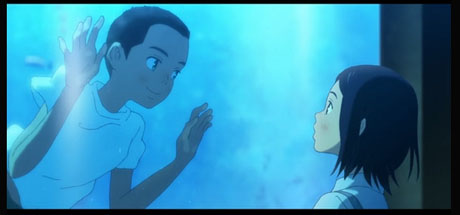
Ayumu Watanabe is the director of the striking new anime film Children of the Sea. It’s available now on Blu-ray and DVD via GKIDS and Shout Factory, and you can also stream the English-language version on Netflix. The story is about a special girl who makes some just-as-special friends. Over the course of the summer, their lives will change as they learn what life really means. (This interview was conducted as an Email Q&A.)
Jackson Murphy: Where did your interest in sea creatures come from?
Ayumu Watanabe: I first got interested from reading a picture book about whales when I was a child. I was fascinated by how large they were and how they evolved from being land creatures to sea creatures.

JM: The detail work is excellent. Which animals were the most difficult to get exactly right?
AW: It makes me happy that you noticed the details in the animation. Each of the creatures was difficult, but we took great pains to get the large size of the whale right.
JM: Aquariums are full of wonder but also mystery. What was your approach in exploring this aspect?
AW: We tried to be creative in the scene where Ruka enters the aquarium. Going through the dark tunnel…I wanted it to be the entrance of a mystical world. I wanted to depict that visitors only see a fraction of the facility when they visit an aquarium. It was the same as the idea of how the ocean is vast and mysterious.
JM: Did summer vacations from school as a child inspire some of the story?
AW: Unfortunately, my childhood summer vacations were dull. But I was always excited that something interesting was going to happen. Maybe that feeling synched with Ruka.
JM: Sometimes it’s more challenging for filmmakers to pull-off complex child characters as their leads. You give us child characters with so much depth. Was this challenging for you?
AW: I always have the main character face the child within me when I create characters. What’s always difficult is waiting for them to move. I’m always careful not to get ahead of the characters when advancing the story. I am an immature adult, so I admire them. Maybe it’s not right as a director, though, haha.
JM: What did you discover about animating water that you never knew before?
AW: I actually wanted to surpass the waves I saw— and was in awe with— in Pinocchio…but I guess that was a reckless ambition. Jokes aside… It wasn’t enough to just animate them realistically. I realized again that it was necessary to amplify the likeness of water.
JM: I really like how you constantly take a close-up of Ruka’s knee as it slowly gets better over the course of the film. What do you like about this technique?
AW: I included her knee as a way to express her feelings without using words. The more the audience saw it, I wanted them to relate to her. I’m happy that you noticed that detail.

JM: The final section of the movie is incredible – a visual spectacle with themes of rebirth and spirituality. What were your overall goals with this sequence?
AW: Even though I’m explaining the theme and intention, the other person doesn’t feel like he’s being explained anything. Or he felt something but is not quite sure what it is. These are what I was going for in this scene. I wanted the audience to feel something visually as much as possible because I’m using the
medium of animation. “One life” is only one transmission that is part of the vast universe. Will is born when an individual consciousness tries to resist the hard facts. Living is a small thing, but it’s wonderful! These are the things I thought about when I animated this scene. I’m curious about how your readers felt when they watched it. I would love to receive their thoughts.
JM: There’s an emotional aspect of temporary enjoyment and saying goodbye. How do you relate to this?
AW: There aren’t many opportunities to say goodbye formally in real life. I have friends I’ve lost touch with without knowing that would happen, so I never said goodbye. We all think that we’ll see each other again, and then so many days and years go by. And at times, the goodbye is caused by death. Looking back, it’s strange that we feel that way. When I animate a parting scene, I always incorporate gratitude for the encounter.
JM: You add a fairly important scene AFTER the end credits. Without spoiling it, why did you decide to place it here?
AW: I wanted to depict the irreversibility of time and individuality as well as the rhythm of metempsychosis as the conclusion of what happened to a girl one summer. I wanted to give her a gentle nudge as she moved on.
- INTERVIEW: Jeff Fowler On “Knuckles” And “Sonic 3” - April 22, 2024
- INTERVIEW: “Inside Out 2” Director And Producer On Pixar Sequel - April 16, 2024
- INTERVIEW: “Puffin Rock And The New Friends” And 25 Years Of Cartoon Saloon - April 10, 2024


 September 17th, 2020
September 17th, 2020  Jackson Murphy
Jackson Murphy  Posted in
Posted in  Tags:
Tags: 






